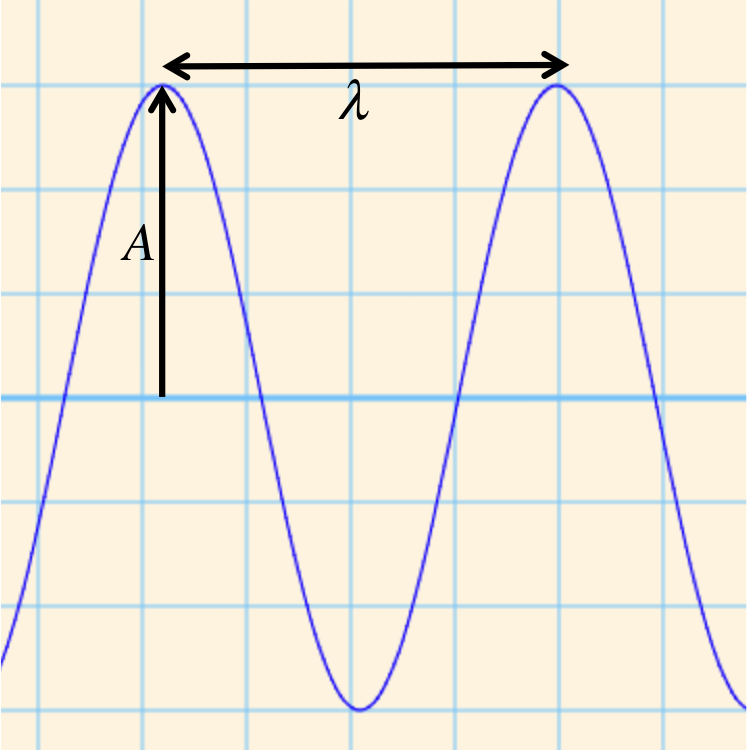Wave Velocity
From the simulation above, you could see that the wave (or each crest of the wave) moves exactly one wavelength ($\lambda$) in one period ($T$), therefore the speed of the wave is given by:
$$
v = \frac{\lambda}{T} = f \lambda
$$
where we used the fact that $\frac{1}{T} = f$.
This equation can be written more conveniently in terms of $\omega=\frac{2\pi}{T}$ and $k = \frac{2\pi}{\lambda}$:
$$
\begin{eqnarray}
v &=& \frac{\lambda}{T} = \frac{2\pi}{T}\frac{\lambda}{2\pi} \\
&=& \frac{\frac{2\pi}{T}}{\frac{2\pi}{\lambda}}\\
&=& \frac{\omega}{k}
\end{eqnarray}
$$
In summary, we have for the velocity of the wave:
$$
v = f \lambda = \frac{\omega}{k}
$$
Just to be perfectly clear, this is the velocity at which the crests of the wave travel along the direction of the wave, not to be confused with transverse velocity below.
Question will be loaded by load_exercise_example_all() defined in script_question.js
Try It Yourself (click to show)
Question will be loaded by load_exercise_example_all() defined in script_question.js
Question will be loaded by load_exercise_example_all() defined in script_question.js
Transverse Velocity
Transverse velocity is the velocity of the particles that made up the wave. For instance, in a transverse wave traveling horizontally, the transverse velocity of each particle will be vertical.
Math Review - Differentiation of Trignometric Functions (Waves)
You need to know how to differentiate $\cos$ and $\sin$ functions to proceed further. We will start with two basic facts:
$$
\begin{eqnarray}
\frac{d}{d\theta}\sin\theta &=& \cos \theta \\
\frac{d}{d\theta}\cos\theta &=& -\sin \theta
\end{eqnarray}
$$
In physics we often differentiate with respect to $t$, like so:
$$
\begin{eqnarray}
\frac{d}{dt}\sin\omega t &=& \omega \cos \omega t \\
\frac{d}{dt}\cos\omega t &=& -\omega \sin \omega t
\end{eqnarray}
$$
Note that every time derivative "pulls down" a factor of $\omega$ due to the chain rule of calculus.
The last step is to include the term $kx$. Fortunately, $kx$ just comes along for the ride and do not change the results. For a wave traveling left:
$$
\begin{eqnarray}
\frac{d}{dt}\sin(kx + \omega t) &=& \omega \cos (kx + \omega t) \\
\frac{d}{dt}\cos(kx + \omega t) &=& -\omega \sin (kx + \omega t)
\end{eqnarray}
$$
For a wave traveling right, simply replace $\omega \rightarrow -\omega$ in the result above:
$$
\begin{eqnarray}
\frac{d}{dt}\sin(kx - \omega t) &=& -\omega \cos (kx + \omega t) \\
\frac{d}{dt}\cos(kx - \omega t) &=& +\omega \sin (kx + \omega t)
\end{eqnarray}
$$
Note that every time derivative "pulls down" a factor of $\pm \omega$ due to the chain rule of calculus.
Using the rules of calculus above, we could derive the following results:
Wave traveling right:
$$
\begin{eqnarray}
y &=& A \sin(kx-\omega t) \\
v_y &=& \dot{y} = -A \omega \cos(kx-\omega t) \\
a_y &=& \dot{v_y} = -A \omega^2 \sin(kx-\omega t)
\end{eqnarray}
$$
Wave traveling left:
$$
\begin{eqnarray}
y &=& A \sin(kx+\omega t) \\
v_y &=& \dot{y} = A \omega \cos(kx+\omega t) \\
a_y &=& \dot{v_y} = - A \omega^2 \sin(kx+\omega t)
\end{eqnarray}
$$
Similar to the argument we used in an example in Chapter 12, since both $\sin$ and $\cos$ functions are bounded within $-1$ and $+1$, the general rule for finding the maximum value of such functions are given by:
$$
\begin{eqnarray}
\big( M \cos \theta \big)_{max} &=& |M| \\
\big( M \sin \theta \big)_{max} &=& |M|
\end{eqnarray}
$$
This gives the maximum transverse velocity and acceleration (for both directions):
$$
\begin{eqnarray}
v_{y, max} &=& A\omega \\
a_{y, max} &=& A\omega^2
\end{eqnarray}
$$
Try It Yourself (click to show)
Question will be loaded by load_exercise_example_all() defined in script_question.js
Question will be loaded by load_exercise_example_all() defined in script_question.js

